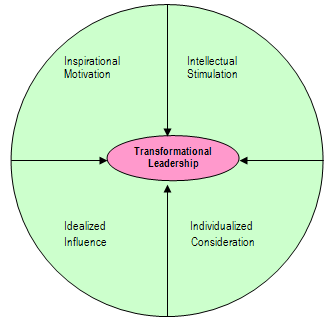1) Synergy:

The situation in which the whole is greater than its parts. In organizational terms, Synergy means that departments that interact cooperatively are more efficient and productive than they would be if they operated in isolation.
2) Theory of Transformation of Leadership:
Creating high-performance workforce has become increasingly important and to do so business leaders must be able to inspire organizational members to go beyond their task requirements. As a result, new concepts of leadership have emerged - transformational leadership being one of them.
Transformational leadership may be found at all levels of the organization: teams, departments, divisions, and organization as a whole. Such leaders are visionary, inspiring, daring, risk-takers, and thoughtful thinkers. They have a charismatic appeal. But charisma alone is insufficient for changing the way an organization operates. For bringing major changes, transformational leaders must exhibit the following four factors:
Model For Transformational Leadership

Inspirational Motivation
The foundation of transformational leadership is the promotion of consistent vision, mission, and a set of values to the members. Their vision is so compelling that they know what they want from every interaction. Transformational leaders guide followers by providing them with a sense of meaning and challenge. They work enthusiastically and optimistically to foster the spirit of teamwork and commitment.
Intellectual Stimulation
Such leaders encourage their followers to be innovative and creative. They encourage new ideas from their followers and never criticize them publicly for the mistakes committed by them. The leaders focus on the “what” in problems and do not focus on the blaming part of it. They have no hesitation in discarding an old practice set by them if it is found ineffective.
Idealized Influence
They believe in the philosophy that a leader can influence followers only when he practices what he preaches. The leaders act as role models that followers seek to emulate. Such leaders always win the trust and respect of their followers through their action. They typically place their followers needs over their own, sacrifice their personal gains for them, ad demonstrate high standards of ethical conduct. The use of power by such leaders is aimed at influencing them to strive for the common goals of the organization.
Individualized Consideration
Leaders act as mentors to their followers and reward them for creativity and innovation. The followers are treated differently according to their talents and knowledge. They are empowered to make decisions and are always provided with the needed support to implement their decisions.
3) Job Rotation:
Job rotation in the workplace is a system where employees work at several jobs in a business, performing each job for a relatively short period of time. Job rotations allow employees to learn about different types of work, giving individual employees a better sense of what their colleagues do and a better overall understanding of the entire organization.
Workplace Training Tool
Job rotations are typically used as a workplace training tool. Spending a few weeks or months working at a job enables employees to get a real understanding of the job and what is involved, as well as a better appreciation of what their fellow employees actually do. Job rotations are a more common practice in medium- to larger-sized businesses, and are often structured as an an "introduction" for new graduates just entering the industry.
Promotes Learning
One advantage to job-rotation schemes is that both employers and employees learn a lot. Employees learn more about the workplace, their colleagues, and what goes into creating the final product or service. Employers learn about individual employee skill sets, and strengths and weaknesses. Employers can use what they learn through job rotations to find the best placement for each employee.
Motivational Tool
Job rotations can be used as a motivational tool. Most employees will welcome an opportunity to learn new skills, especially if the new position is higher paying, or perceived as easier or more prestigious. Occasionally, interdepartmental jealousies or other frictions surface at the workplace. Some managers set up job-rotation schemes as a way to help employees develop appreciation for the work of their colleagues.
Disadvantage
Job rotation does have a downside. A number of researchers have pointed out that while job-rotation systems certainly do lead to a better understanding of business processes and the company as a whole, they do not encourage in-depth expertise. This can lead to longer learning curves for new employees to come up to speed in their regular positions.
No comments:
Post a Comment